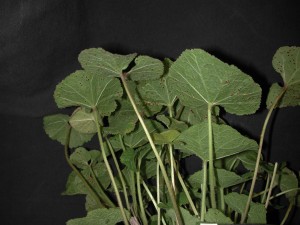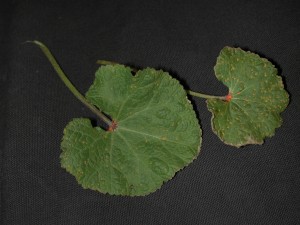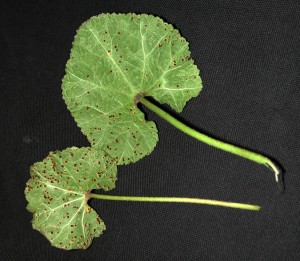Hollyhock rust – Puccinia malvacearum
Pathogen: Puccinia malvacearum
Hosts: Alcea, Althaea, Lavatera, and Malva.
Symptoms: Small brown spots develop on the underside of foliage. Raised, bright yellow or orange pustules are visible on the upper leaf surface. When disease is severe large portions of the foliage are killed.
Spread: Spores can over winter on diseased plant tissues infecting new foliage the following year. Spores are also produced on susceptible weeds these can subsequently infect and cause disease on hollyhocks. Spores are wind dispersed.
Management: Disease control on seedlings is especially important. Fungicide applications at regular intervals are necessary when disease is severe. Plants should be cut back as soon as flowering is done. Plant debris should be removed and destroyed, it should not be composted. Several weeds (in the mallow family) are also susceptible; these weeds should be controlled to limit inoculum in the growing area.



Other Documents in this Series
You Might Also Be Interested In
-
4-H Smart Money Contests for youth pay off
Published on February 23, 2023
-
Ghost, goblins and managing money?
Published on October 26, 2015
-
Do you want to teach financial education to youth?
Published on February 20, 2017
-
Thrift, make and buy: The top levels of the Buyerarchy of Needs
Published on April 7, 2015
-
Learn how to build wealth during Money Smart Week 2018
Published on March 28, 2018
-
Smart spending for the holidays happens when you have a plan
Published on December 6, 2017
Accessibility Questions:
For questions about accessibility and/or if you need additional accommodations for a specific document, please send an email to ANR Communications & Marketing at anrcommunications@anr.msu.edu.



 Print
Print Email
Email



